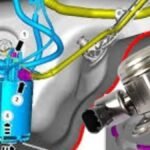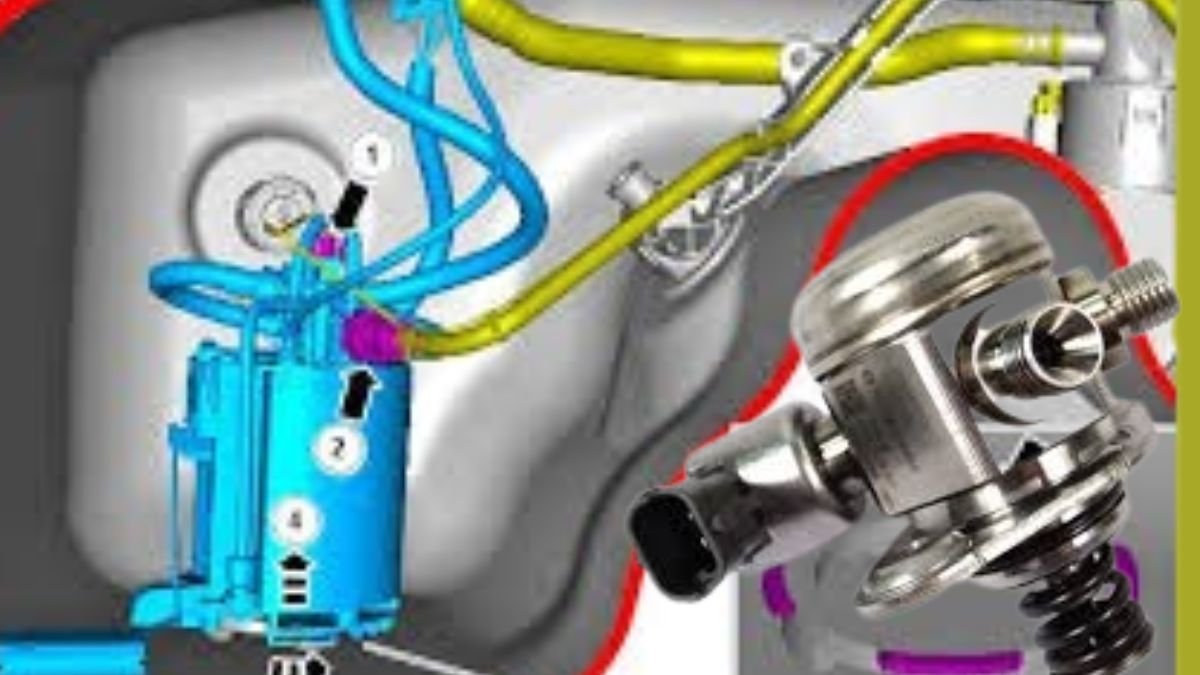Experiencing a 2019 Range Rover Sport L494 Fuel Pressure Issue can be frustrating and concerning. This problem can cause your vehicle to lose power, fail to start, or stall unexpectedly, leading to potential safety risks. This article explores the underlying causes of this issue, provides troubleshooting tips, and offers expert solutions to help you get your Range Rover back on the road.
Understanding the 2019 Range Rover Sport L494 Fuel System
The fuel system in the 2019 Range Rover Sport L494 is a sophisticated network of components designed to deliver fuel from the tank to the engine efficiently. It includes the fuel pump, fuel injectors, fuel lines, and pressure sensors, all of which work together to maintain optimal fuel pressure. When any of these components malfunction, it can result in the “no fuel pressure” condition, which requires immediate attention.
The Role of Fuel Pressure in Your Range Rover’s Performance
Fuel pressure is crucial to your Range Rover’s performance. It ensures that the engine receives the right amount of fuel at the right time, leading to smooth operation. Without proper fuel pressure, the engine may struggle to start, run inefficiently, or not run at all. The 2019 Range Rover Sport L494, with its advanced engine management system, relies heavily on precise fuel delivery to achieve its high-performance standards.
Common Symptoms of No Fuel Pressure in the 2019 Range Rover Sport L494
Identifying the symptoms of a “no fuel pressure” problem can help diagnose the issue early. Here are some common signs to watch for:
- Engine Cranks but Doesn’t Start: This is one of the most common symptoms, indicating that the fuel is not reaching the engine.
- Sudden Engine Stalling: The vehicle may start but stall shortly after, often without warning.
- Loss of Power: Noticeable reduction in power, especially during acceleration.
- Fuel Pump Noise: Unusual whining or buzzing sounds from the fuel pump, indicating a malfunction.
- Check Engine Light: The dashboard may display a warning light related to the fuel system.
Diagnosing the No Fuel Pressure Problem
Before diving into solutions, it’s essential to properly diagnose the problem to avoid unnecessary repairs. Here’s how to diagnose the no fuel pressure issue in your 2019 Range Rover Sport L494:
Step 1: Check for Diagnostic Trouble Codes (DTCs)
Using an OBD-II scanner, check for any diagnostic trouble codes. Codes like P0087 (Fuel Rail/System Pressure – Too Low) or P0191 (Fuel Rail Pressure Sensor Circuit Range/Performance) can provide clues about the root cause.
Step 2: Inspect the Fuel Pump Relay and Fuse
The fuel pump relay and fuse are critical for delivering power to the fuel pump. If either is faulty, the pump won’t operate, leading to no fuel pressure. Inspect and replace these components if necessary.
Step 3: Test the Fuel Pump and Fuel Pressure
If the relay and fuse are intact, the next step is to test the fuel pump. You can use a fuel pressure gauge to measure the pressure in the fuel line. If the reading is below the manufacturer’s specifications, the fuel pump might be failing.
Step 4: Examine the Fuel Filter
A clogged fuel filter can restrict fuel flow, causing low or no fuel pressure. Inspect the filter and replace it if it shows signs of blockage.
Read Also : BounceMediaGroup.com Social Stat Digital Media Mastery in 2024
Common Causes of No Fuel Pressure in the 2019 Range Rover Sport L494
Understanding the causes of no fuel pressure can help you address the issue more effectively. Here are some of the most common causes:
Faulty Fuel Pump
A faulty fuel pump is often the primary culprit behind no fuel pressure issues. The pump may fail due to wear and tear, electrical issues, or contamination in the fuel. When the pump doesn’t operate correctly, it cannot supply fuel to the engine, leading to a no-start condition.
Clogged Fuel Filter
Over time, dirt and debris can accumulate in the fuel filter, restricting fuel flow. A severely clogged filter can lead to a complete lack of fuel pressure, preventing the engine from starting.
Malfunctioning Fuel Pressure Regulator
The fuel pressure regulator controls the amount of pressure in the fuel rail. If it malfunctions, it can either cause too much or too little pressure, both of which can lead to engine performance issues.
Electrical Issues
Wiring problems, corroded connectors, or a malfunctioning fuel pump relay can prevent the fuel pump from receiving power. These electrical issues can be challenging to diagnose but are a common cause of no fuel pressure.
Failed Fuel Injectors
While less common, failed fuel injectors can also contribute to a no fuel pressure condition. If the injectors are clogged or stuck closed, fuel won’t be delivered to the engine, resulting in a no-start scenario.
Fixing the No Fuel Pressure Issue in Your 2019 Range Rover Sport L494
Once you have diagnosed the problem, the next step is to fix it. Depending on the underlying cause, different solutions may be required.
Replacing the Fuel Pump
If the fuel pump is faulty, replacing it is the only solution. This involves removing the fuel tank to access the pump. It’s recommended to use a genuine Land Rover fuel pump to ensure compatibility and longevity.
Changing the Fuel Filter
Replacing the fuel filter is a relatively straightforward task. However, ensure you use a high-quality filter that meets the manufacturer’s specifications to prevent future issues.
Inspecting and Repairing Electrical Connections
If electrical issues are to blame, carefully inspect all wiring and connectors related to the fuel pump circuit. Repair or replace any damaged components to restore proper operation.
Replacing the Fuel Pressure Regulator
If the fuel pressure regulator is malfunctioning, replacing it can resolve the no fuel pressure issue. It’s important to use a regulator that matches the exact specifications of your Range Rover’s engine.
Cleaning or Replacing Fuel Injectors
If clogged or malfunctioning injectors are identified, they may need to be cleaned using specialized equipment or replaced entirely.
Preventative Measures to Avoid Future Fuel Pressure Issues
To prevent future occurrences of no fuel pressure in your 2019 Range Rover Sport L494, consider the following preventative measures:
- Regular Maintenance: Stick to the recommended maintenance schedule, including fuel system inspections and fuel filter replacements.
- Use High-Quality Fuel: Avoid using low-grade or contaminated fuel, as it can damage the fuel pump and injectors.
- Keep the Fuel Tank Full: Running on a low fuel level can cause the pump to overheat, leading to premature failure.
- Monitor for Symptoms: If you notice any early signs of fuel pressure issues, address them immediately to avoid more significant problems.
How the 2019 Range Rover Sport L494’s Fuel System Differs from Other Models
The 2019 Range Rover Sport L494 features an advanced fuel system that is distinct from earlier models. This system is designed to enhance fuel efficiency and performance while meeting stringent emissions standards. Understanding these differences can help owners and technicians better diagnose and repair fuel-related issues.
Advanced Fuel Injection Technology
The L494 model is equipped with direct fuel injection technology, which delivers fuel directly into the combustion chamber. This system requires higher fuel pressure than traditional port injection systems, making it more sensitive to fuel delivery issues.
Integrated Fuel Pump Control Module
Unlike earlier models, the 2019 Range Rover Sport L494 uses an integrated fuel pump control module that precisely manages fuel pressure. This module communicates with the engine control unit (ECU) to adjust fuel delivery based on driving conditions, making it a critical component in the overall performance of the vehicle.
Enhanced Fuel Efficiency and Emissions Control
The L494’s fuel system is designed to optimize fuel efficiency and reduce emissions. This is achieved through precise control of fuel pressure and injector timing, making it essential for the system to function correctly.
Conclusion
The “no fuel pressure” issue in a 2019 Range Rover Sport L494 can be a daunting problem, but with the right knowledge and approach, it is manageable. Understanding the symptoms, diagnosing the root cause, and addressing the specific component failures—whether it’s the fuel pump, filter, pressure regulator, or electrical issues—are essential steps in restoring your vehicle’s performance. Regular maintenance and using quality fuel can prevent many of these problems from arising. However, if the issue persists despite troubleshooting, consulting a professional mechanic with experience in luxury vehicles like the Range Rover is advisable. By taking timely action, you can avoid further complications and ensure that your Range Rover continues to deliver the performance and reliability it’s known for.
Frequently Asked Questions
What are the signs of low fuel pressure in a 2019 Range Rover Sport L494?
Signs include engine cranking without starting, loss of power, stalling, unusual fuel pump noises, and a check engine light.
How do I test the fuel pressure in my Range Rover Sport L494?
You can use a fuel pressure gauge connected to the fuel rail to measure the pressure. Compare the readings to the manufacturer’s specifications.
Can a clogged fuel filter cause no fuel pressure?
Yes, a severely clogged fuel filter can restrict fuel flow, leading to no fuel pressure and engine failure to start.
Is it safe to drive with low fuel pressure?
No, driving with low fuel pressure can cause engine damage, reduce performance, and increase the risk of stalling, especially during critical maneuvers.
How often should I replace the fuel filter in my Range Rover Sport L494?
It’s recommended to replace the fuel filter every 30,000 to 40,000 miles or as specified in your vehicle’s maintenance schedule.
Can I fix the no fuel pressure issue myself?
If you have the proper tools and experience, you can fix minor issues like replacing a fuel filter. However, complex problems like a faulty fuel pump should be handled by a profession.











